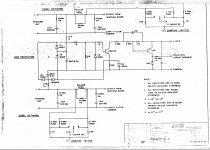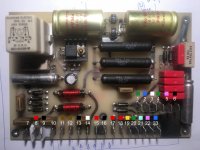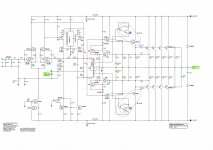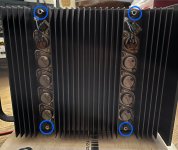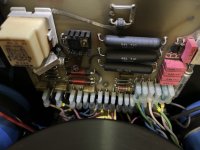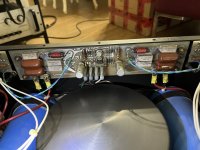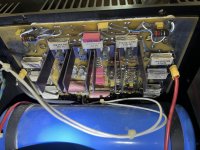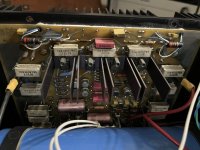GKTAUDIO, this n°27 is definitely a nice beast!
Much more populated board than the ML-9... everything is there, nearly the same components but their number is double!
I'm impressed by the size of the cables going from the capacitor bar...
Thank you for sharing, I guess it will be interesting to many.
Much more populated board than the ML-9... everything is there, nearly the same components but their number is double!
I'm impressed by the size of the cables going from the capacitor bar...
Thank you for sharing, I guess it will be interesting to many.
Thanks GKTAUDIO, I could have your No. 27 power board's layout drawing if it can help me to understand the circuit, if I'm smart enough to see similarities with the 9. Thank you for that. I'm not an expert, and don't know as much as you all do about those things, electronics and so.
I know it'll be some sport to achieve what I'm willing to do. But as you say, the house is not empty of machines and I'm happy to listen to different systems. So it can take some time, anyway the two big cans won't be shipped before July (made at the factory at that time), and I should be pensioned or equivalent in April. I've got time and can be patient. Or try to.
I thank you all for your inputs, and I hope that this thread (which is not over😉 can be useful to others.
Take care! That bloody virus won't kill music whether it's live or reproduced.
I know it'll be some sport to achieve what I'm willing to do. But as you say, the house is not empty of machines and I'm happy to listen to different systems. So it can take some time, anyway the two big cans won't be shipped before July (made at the factory at that time), and I should be pensioned or equivalent in April. I've got time and can be patient. Or try to.
I thank you all for your inputs, and I hope that this thread (which is not over😉 can be useful to others.
Take care! That bloody virus won't kill music whether it's live or reproduced.
Last edited:
Hi! to all and everyone. Long time without writing and giving some news from my work on the ML-9, sorry about that.
Then, in one word, I replaced all that seemed necessary at first sight, and I'm quite satisfied with the result, both sonically and aesthetically (mean quality of soldering 😉.
- Why are you satisfied, old man? - Uh, I've got plenty of time so I'm not in the same position as the professional fixer. Basically, these guys (why guys? some must be women!) are probably much better than me in most aspects of a repair including plying resistors or diodes legs, soldering, cleaning etc... BUT if I need to rest during 1 hour after replacing a capacitor, I can do it 😉
So I'll let you know about all that and what I didn't do (also), with pictures if it helps next people reading that thread. In the meantime, I just repaired a ML36 DAC whose left channel was not working (and preparing a kind of description of the different steps I took). So no time for self-boring.
Right now, to all who gave their (good) advices here, 2 words: THANK YOU.
I'll be back soon.
Then, in one word, I replaced all that seemed necessary at first sight, and I'm quite satisfied with the result, both sonically and aesthetically (mean quality of soldering 😉.
- Why are you satisfied, old man? - Uh, I've got plenty of time so I'm not in the same position as the professional fixer. Basically, these guys (why guys? some must be women!) are probably much better than me in most aspects of a repair including plying resistors or diodes legs, soldering, cleaning etc... BUT if I need to rest during 1 hour after replacing a capacitor, I can do it 😉
So I'll let you know about all that and what I didn't do (also), with pictures if it helps next people reading that thread. In the meantime, I just repaired a ML36 DAC whose left channel was not working (and preparing a kind of description of the different steps I took). So no time for self-boring.
Right now, to all who gave their (good) advices here, 2 words: THANK YOU.
I'll be back soon.
I have 2 ML-9 amps, and I'm getting ready to repair one of them. I am fairly sure this is a power supply problem. Before I start, any diagrams, disassembly advice, part sources, etc you can provide would be incredibly helpful. Thanks so much.Hi! to all and everyone. Long time without writing and giving some news from my work on the ML-9, sorry about that.
Then, in one word, I replaced all that seemed necessary at first sight, and I'm quite satisfied with the result, both sonically and aesthetically (mean quality of soldering 😉.
- Why are you satisfied, old man? - Uh, I've got plenty of time so I'm not in the same position as the professional fixer. Basically, these guys (why guys? some must be women!) are probably much better than me in most aspects of a repair including plying resistors or diodes legs, soldering, cleaning etc... BUT if I need to rest during 1 hour after replacing a capacitor, I can do it 😉
So I'll let you know about all that and what I didn't do (also), with pictures if it helps next people reading that thread. In the meantime, I just repaired a ML36 DAC whose left channel was not working (and preparing a kind of description of the different steps I took). So no time for self-boring.
Right now, to all who gave their (good) advices here, 2 words: THANK YOU.
I'll be back soon.
Hi lbairn, welcome on this thread.
I attach 3 files that could help you... You write about a PSU problem, is there a specific detail which makes you think about that?
I've got other pictures (of my machine) if you need. My model was a 110V adapted to 230V (France) by an expert when I received it (bought on eBay in 2009).
Very nice amp.
I attach 3 files that could help you... You write about a PSU problem, is there a specific detail which makes you think about that?
I've got other pictures (of my machine) if you need. My model was a 110V adapted to 230V (France) by an expert when I received it (bought on eBay in 2009).
Very nice amp.
Attachments
I'm guessing PSU because the amp was working fine, I turned it off and about 60 seconds later, turned it back on, and it was just dead. The power light on the front doesn't come on. In most amps, this problem would be a blown fuse, but this ML-9 has no fuses. (I'm not familiar with the power switch, but some threads indicate that it might also be some type of breaker...instead of using a fuse?) Because neither channel works, I'm guessing that neither +15 nor -15 is working, but I haven't measured anything yet. If that's the case, then the problem will be something in the PSU that's common to both + and - rails.
OK, I see what you mean. No fuse you are right. If no light comes on the switch, then I suppose you won't find any current inside. I would suggest (but I'm no specialist at all) that you investigate what I called "regulation board" where you'll find the relay. Get some voltage measurements in and out the relay. I've read somewhere that it could fail. I bought 2 as spare parts just in case (I'm not living in the US where they are easy to find). Merry Xmas, by the way.
Merry Christmas to you, too...I'm passing time waiting for the grandkid to arrive. The power switch appears to be defective, and I'm having some difficulty finding a replacement. There's a thread discussing the power switch for the ML-2
https://www.diyaudio.com/community/threads/mark-levinson-ml-2-airpax-power-switch.119570/
but that's a 3-pole Airpax switch, and the ML-9 uses a 2-pole switch, also made by Airpax. There are no part numbers anywhere on the switch. I really need a schematic of that power supply so maybe I can identify the correct Airpax part number. I have an Airpax spec switch, but I'm still having difficulty identifying the correct part number.
Do I recall that you're using these ML-9 amps to drive Apogee speakers?
https://www.diyaudio.com/community/threads/mark-levinson-ml-2-airpax-power-switch.119570/
but that's a 3-pole Airpax switch, and the ML-9 uses a 2-pole switch, also made by Airpax. There are no part numbers anywhere on the switch. I really need a schematic of that power supply so maybe I can identify the correct Airpax part number. I have an Airpax spec switch, but I'm still having difficulty identifying the correct part number.
Do I recall that you're using these ML-9 amps to drive Apogee speakers?
Good pastime, if you meet success... the only thing I know about this particular switch is the specificity of the led inside, which is part of the switch and rather unusual in the way it is built (if I understood well what I read). The thread you mention points out the necessity for such a switch to handle a rather strong current when power is applied. That means that any replacement should take that into account, of course.
I'm sorry not being able to give you more information about the power schematics as I don't get them at hand. Maybe some other readers will be able to help you with that point. The only thing I know about the transformer (capacity 1200VA) does not make it easy to determine the minimal handling current capacity of the switch, but we can assume that the ML-9 draws a minimum of 20A when powering it on. Minimum, I'd say. Considering the two 36000µF/100V capacitors inside, I'm pretty sure that the current flow in the switch can go high when pressing it on.
Yes you are right, the ML-9 drives Apogee Speakers. Modified Centaur Minor and/or Stage. I also (more often) use a Cello Encore 50w double mono amp which, despite its lower power capacity, is more at ease with dynamics than the ML-9, IMHO.
I'm sorry not being able to give you more information about the power schematics as I don't get them at hand. Maybe some other readers will be able to help you with that point. The only thing I know about the transformer (capacity 1200VA) does not make it easy to determine the minimal handling current capacity of the switch, but we can assume that the ML-9 draws a minimum of 20A when powering it on. Minimum, I'd say. Considering the two 36000µF/100V capacitors inside, I'm pretty sure that the current flow in the switch can go high when pressing it on.
Yes you are right, the ML-9 drives Apogee Speakers. Modified Centaur Minor and/or Stage. I also (more often) use a Cello Encore 50w double mono amp which, despite its lower power capacity, is more at ease with dynamics than the ML-9, IMHO.
Hello guys,
this thread has been very my main source of technical information about the ML-9 which I bought on auction and received few days ago. The overall condition looks fine but I would like to inspect it in more details. May you help me on how to open it? I unscrewed the top cover but it doesn't lift, should I unscrew the transistor boards on the sides?
Please apologise if these question sound a bit "basic" 🙂
this thread has been very my main source of technical information about the ML-9 which I bought on auction and received few days ago. The overall condition looks fine but I would like to inspect it in more details. May you help me on how to open it? I unscrewed the top cover but it doesn't lift, should I unscrew the transistor boards on the sides?
Please apologise if these question sound a bit "basic" 🙂
Absolutely. You have to unscrew the black transistor’s covers (2 on each side), then “release” the 2 or 4 (don’t remember and not home) screws that fix the whole amp plate (one on each side, radiator and PCB hold together). You don’t have to unscrew them completely to let enough free space to be able to lift the cover.
Thank you so much! Now I can proceed with confidence to open the case. Looking through the ventilation grids I could see quite a bit of dust but not much more, this way I can check, for example, if there was any capacitor leakage
It's normal to get some dust after a few years, with the vented cover. Easy to get rid of, with some blow gun or sort of. I doubt you'll find any leaking capacitor...
It's easy to access to the amp circuits, by unscrewing completely the two sides.
Then you should see something like this :

and the amp circuit :

If you have any question, just ask. I did some (light) recapping 2 years ago (all capacitors except on the amp board which is quite difficult to dismantle and get access to the solder side), after a complete disassembling. It works fine. I tested caps on the amp boards and they were fine. There was one big can (36000µF/100V) which wasn't in the specs and I ordered 2 from Nippon Chemical (at Mouser), waited for 6 months to have them, but I wanted same size/same colour 😉. Finally, I could reform the one that was wrong and it is perfect now. But replacement was done already and the one I bought are perfect and will last 30 more years...
Enjoy!
Jérôme
It's easy to access to the amp circuits, by unscrewing completely the two sides.
Then you should see something like this :
and the amp circuit :
If you have any question, just ask. I did some (light) recapping 2 years ago (all capacitors except on the amp board which is quite difficult to dismantle and get access to the solder side), after a complete disassembling. It works fine. I tested caps on the amp boards and they were fine. There was one big can (36000µF/100V) which wasn't in the specs and I ordered 2 from Nippon Chemical (at Mouser), waited for 6 months to have them, but I wanted same size/same colour 😉. Finally, I could reform the one that was wrong and it is perfect now. But replacement was done already and the one I bought are perfect and will last 30 more years...
Enjoy!
Jérôme
Hi Jerome,
thanks a lot for pictures and information. This evening, once back home, I will open it and enjoy the show of top class audio electronics. I don't know how to check caps, this would be interesting to know... 🙂
thanks a lot for pictures and information. This evening, once back home, I will open it and enjoy the show of top class audio electronics. I don't know how to check caps, this would be interesting to know... 🙂
Something like this for example : esr-meter
What is practical with this small tool is that you can check ESR in circuit. It won't go up the capacity of the 2 Spragues (36mF each) but useful for others. Other than this, a good Fluke or analogue will let you know many things (beside an oscilloscope).
But mainly, you shouldn't have many things to do with your ML-9, if anything... It's build to go on the moon and will last a long time without replacing anything.
The only caps I wanted to replace absolutely are the Y Rifa caps on the PSU board (which are not known for lasting a lifetime) :

and the 2 Frako's (10000µF/6V) on the same board (and same reasons) :

While I was there and the amp open, I replaced all others I could with good quality caps from Vishay or Sprague or Nippon Chemical bought at Mouser. So I know what's inside.
What is practical with this small tool is that you can check ESR in circuit. It won't go up the capacity of the 2 Spragues (36mF each) but useful for others. Other than this, a good Fluke or analogue will let you know many things (beside an oscilloscope).
But mainly, you shouldn't have many things to do with your ML-9, if anything... It's build to go on the moon and will last a long time without replacing anything.
The only caps I wanted to replace absolutely are the Y Rifa caps on the PSU board (which are not known for lasting a lifetime) :
and the 2 Frako's (10000µF/6V) on the same board (and same reasons) :
While I was there and the amp open, I replaced all others I could with good quality caps from Vishay or Sprague or Nippon Chemical bought at Mouser. So I know what's inside.
Let me say it is a real pleasure talking to you, thanks a lot for the advise and the information. I will open the amp and post pictures of the interior so, if you have time, you can give a look and tell me if there is anything urgent to be done
Thanks, it's the principle of this place! many other members have been kind to me the same way, thanks to them.
Please do, I'll try to do my best to help or assist. Remember that I'm not a professional, so take advice from others too, there are some really tough guys here). I'm sure many people read this thread, and ML fans are numerous.
By the way, congrats for your ML-9, a very very good amp at an affordable price today...
Please do, I'll try to do my best to help or assist. Remember that I'm not a professional, so take advice from others too, there are some really tough guys here). I'm sure many people read this thread, and ML fans are numerous.
By the way, congrats for your ML-9, a very very good amp at an affordable price today...
Good morning. I just started the opening but I think I stepped into an obstacle.
I removed the 10 screws from the top panel, uncovered the transistors on the side and released the 6 screws on the lateral panel but still this one doesn't want to move.
Should also the four posts marked in the picture be removed/released?
I removed the 10 screws from the top panel, uncovered the transistors on the side and released the 6 screws on the lateral panel but still this one doesn't want to move.
Should also the four posts marked in the picture be removed/released?
Attachments
Yes gaetanov, you have to unscrew (lightly is enough) the 4 nuts you circled. They're also part of the board fixing to the chassis.
Beware, they are imperial size, not metric. Not a problem if it comes easily, but be cautious. And remember, if you take this 4 nuts out completely, the amp board/side is not held anymore, so it falls on the side (not good with the cables...).
Good day.
Beware, they are imperial size, not metric. Not a problem if it comes easily, but be cautious. And remember, if you take this 4 nuts out completely, the amp board/side is not held anymore, so it falls on the side (not good with the cables...).
Good day.
Last edited:
Yes, they are imperial size, I realized that their size falls between metric 6 and 7 but I was easily able to unscrew them with a metric 6.5.
Actually I took the nuts out completely, I read your post right after, but the sides were held in place by the cables that are quite thick 🙂
Please find here after some pictures of the internals after a little bit of dust removal. If you have a little time to check them, please let me know if you see anything weird. Once again, thanks in advance for your precious suggestions.
Actually I took the nuts out completely, I read your post right after, but the sides were held in place by the cables that are quite thick 🙂
Please find here after some pictures of the internals after a little bit of dust removal. If you have a little time to check them, please let me know if you see anything weird. Once again, thanks in advance for your precious suggestions.
Attachments
- Home
- Amplifiers
- Solid State
- Mark Levinson ML-9 recapping (1985)
